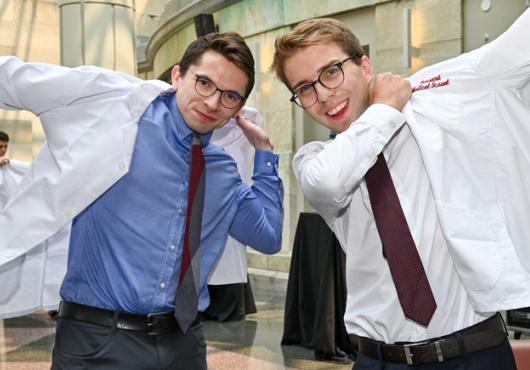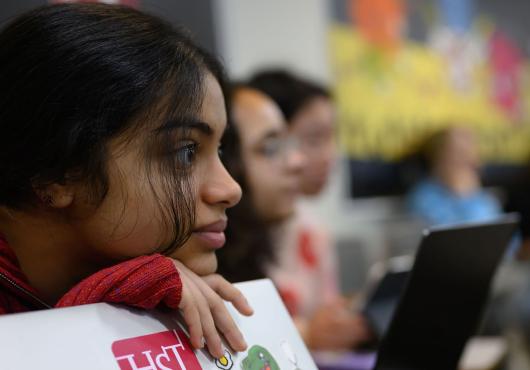As part of a new curriculum approach this year for Harvard Medical School students in the Harvard-MIT Program in Health Sciences and Technology (HST), members of this year’s entering class were invited to meet patients during the students’ very first weeks of medical school as part of a component called Patients First. The goal was to introduce the aspiring physician-scientists — early in their training — to people’s experiences of illness. The idea was to nurture the passion that drew them to become physicians, and help them keep patient care as a guiding force in their studies and future careers.
The following are reflections recorded by three HMS students in their own words about their experiences.
By ALAINA BEVER
The milestone Introduction to the Profession course which occurs during an HMS student’s first year of medical school comprises a number of firsts: putting on a white coat for the first time, obtaining one’s first stethoscope, even the first day of class as a medical student.
Despite our excitement at having the opportunity to dive deep into the underpinnings of human health and disease during our first two years, it can be a bit of a disappointment to realize that many months of training stand between white coat day and the first time we will be able to meet and diagnose our own patients. For many of us then, the most meaningful event during our first week this year was the opportunity to talk with patients one-on-one for the first time.
For the first time, first-year HST students were given the opportunity to get a glimpse into a patient’s experience during the new Growth of the Physician-Scientist curriculum in the HST program.
The Patients First experience paired first-year students with practicing physicians and physician scientists at Dana Farber Cancer Institute, and many of us had the chance to sit down one-on-one for a conversation with a patient.
We had been told during orientation what a privilege the patient-physician relationship is; now we were about to have our chance to experience it firsthand.
After an afternoon spent learning about sarcoma diagnosis and management alongside my designated physician, the time had come for me to talk one-on-one with Fran, a retired nurse who had brought a stack of notes and calendars with her to her follow-up appointment.
I had been looking forward to the conversation and was curious to learn more about Fran’s experience as a cancer patient, a field with which I have little experience. While Fran was awaiting chemotherapy she spoke animatedly, telling me all about how she became a patient at Dana-Farber and how she found a physician who she could tell cared about her personal experience as well as the treatment outcomes. Finally, Fran emphasized the importance of a physician who is honest and open with his or her patients.
Before the Patient’s First experience, I had expected to have an interesting conversation with Fran and affirm what I had learned during orientation about the patience, humility and listening skills that make a good doctor great. What I hadn’t expected was to expand my understanding of what it means to be a physician-scientist.
When I decided to pursue a career in medicine that incorporates a significant amount of research time, I had thought of the two pursuits as synergistic but distinct: the one-on-one interactions with patients in the physician role would be a chance to help individuals, and the research would be my contribution to the wider population of patients who I would never meet.
What I realized after talking with Fran, however, is that to be a physician and a scientist is to be a physician who is keeping up with new research findings and the latest science—not just to add discoveries to the scientific body of knowledge but to provide the best care possible for the patients we meet on a daily basis.
It seems intuitive, but until I had a chance to sit down with Fran, I never realized how much the quality of an individual’s care is connected to the physician’s scientific knowledge, which stems from keeping up with the latest research findings and, for many physicians, participating in research themselves.
Now, many weeks into class, I find my state of mind oscillating between curiosity and joy at learning with my classmates, along with a yearning to return to the hospital to talk with more patients. The opportunity to talk with Fran during my second week at school, although brief, will be an experience that I remember for many years.
The privilege of patient-physician interactions, and the trust that emerges between both parties when patients tell their stories, cannot be entirely communicated through lessons in the classroom. They are lessons that can only be learned through experience. They are lessons that make medicine both an art and a science.
By BLAKE SMITH
This August, my 29 HST classmates and I walked over to Dana-Farber Cancer Institute in our newly-minted white coats. In a slight New England drizzle, amidst sirens and nervous chatter, we became familiarized with new shortcuts and alleyways in the stretch between HMS and Dana-Farber. More importantly, however, we were introduced to patients.
Patients First, a new initiative by HST faculty and former students to incorporate early exposure to patients into the HST curriculum, is a way to bring first-year students closer to the clinic before pre-clinical coursework begins.
We were assigned to shadow individual physicians from across Dana-Farber’s various clinical departments and, throughout the afternoon, we were given the opportunity to speak with patients about their experiences one-on-one.
I was fortunate to shadow Sahar Nissim, a gastroenterologist who specializes in hereditary cancer syndromes. An HST alum and an instructor at HMS, Dr. Nissim’s academic interest in cancer genetics was both clear and infectious. Pedigrees lifted off patients’ charts and into patients’ chairs as Dr. Nissim took great care in discussing delicate matters of familial cancer risk.
I was immediately struck by the deference patients showed Dr. Nissim, even upon first meeting him. I saw how their initial worry dissipated during his tranquil, even-toned discussion of medical genetics, and I witnessed how he approached each conversation by tailoring it to the patient and their particular case.
I was awed by the honesty of each patient and how receptive they were to the questions he asked—from accepting my presence in the room to their candor about lifestyle habits. When Dr. Nissim asked two of his patients if I could stay after to briefly chat with them, they both exclaimed, “Absolutely! Please, ask me anything.”
One of the patients that I was fortunate enough to speak with was one of the first patients to be screened for a BRCA1 mutation in the late 1990s. It was incredible to see how knowledge regarding her genome not only helped her doctors diagnose her other cancers earlier, but how BRCA1/2 mutation screening has helped keep patients like her alive for almost two decades.
About two years ago, Dana-Farber called her to see if she would like to get high-risk cancer gene sequencing performed. She told them how she had done that about 20 years prior and that there was no need, but they then informed her that instead of one gene, they were now sequencing about 350 genes through their OncoPanel to create a personalized OncoMap of each patient. She could not believe how far medicine had come and how she had lived to see it all.
Ultimately, after the screening, she found that she still only had the one, stubborn BRCA1 mutation, but her knowledge of her genome and what that could mean for her and her family was empowering. It also allowed physicians like Dr. Nissim to provide her with more personalized care.
As I was leaving the room, my first patient reflected on the day’s visit and smiled.
“These are the types of doctors we have here,” she said.
Reflecting on my day’s visit in my new role as a medical student, I turned to her and smiled back.
“I agree,” I said.
By SAMANTHA HOFFMAN
The assignment seemed simple enough. After shadowing a physician at Dana-Farber Cancer Institute, I was to sit down with one of the patients and learn what the patient experience was like. Conducting my first patient interview (albeit a nonclinical one) was a moment I had been waiting for and I could not wait to step into the medical profession for a day.
After a brief overview and a brisk walk to Dana-Farber, I found myself in a workroom surrounded by gastrointestinal oncologists. I introduced myself to my preceptor and his fellow, and the two of them briefed me on their next patient.
David was a patient with advanced colon cancer “who will talk your ear off,” they told me in between their discussion of treatment plans and options. He would make a prime interview candidate.
Encouraged, I assumed the traditional shadower’s role as we stepped into the clinic room: seated in the corner, out of the way but still close enough to observe. As the physician began the visit, I noted his seamless transitions between personal questions and medical inquiry, admiring his ability to simplify complicated oncological phenomena into easily digestible information.
Even though David spent the entire visit cracking jokes with the team, I looked for potential issues I could raise with him later, such as the slightly defensive posture that the doctor assumed when David’s wife challenged him on a suggested therapy.
Finally, the visit drew to a close. As my preceptor left, I took a seat in front of David and prepared to launch into my questions—only to realize that I suddenly didn’t know what to say.
All of the questions I wanted to ask, all of the assumptions I had made about what his patient perspective comprised now seemed wholly presumptuous. Embarrassment flushed my face as I rolled up the oversized sleeves of my white coat, feeling more than ever like a child playing pretend.
I looked up to see David and his family waiting patiently for me to begin. I took a deep breath and asked the only question I could think of: “Can you tell me what it’s like to be you today?”
David started by explaining his diagnosis and prognosis, but as time passed our conversation turned to his life outside of the hospital. His ultimate goal, he said with happiness-crinkled eyes, was to take out the trash like he used to do before his cancer; that’s how he would know his life was truly back to normal.
He said the two lights of his life—his young daughters—were his motivation to keep fighting, and he said his coworkers provided a support group no hospital could ever hope to rival.
By far the most striking revelation came towards the end of the interview, when I asked him how he maintained his joviality in the face of his prognosis.
“You only get two minutes down the rabbit-hole,” his wife answered from beside me.
“It’s easy to lose yourself to dark thoughts when you’re battling cancer,” David said. “I tell myself that I only get two minutes down the ‘rabbit-hole’ of those dark thoughts, and then I have to pull myself out, to keep fighting.” He pauses. “I don’t know that I would be here otherwise.”
We let that sentiment sit for a moment, feeling its weight rest heavy on the shoulders of all present. Deciding that I had monopolized enough of their time, I asked if they had any advice for me as a future physician.
“Be human,” David said. “That’s all it takes—be there for people. Dark times need major kindness.”
Those words followed me on my rainy walk back to the medical school. I thought back on the genuine respect and trust that David had for the physician with whom he was working, and I marveled at David’s description of his doctor as “a teammate against a common enemy.” There was no protocol you can adapt, I realized, to gain the ability to simultaneously treat someone for a disease but also refuse to define them by it.
Transitioning back now to our basic science curriculum, I will hold on to this experience as a constant reminder of the balances we must make as future physician-scientists.
Communicating the science behind our future patients’ illnesses can only go so far; compassion makes the difference between a mere clinic room and a comfortable care environment.
Patients First was my first opportunity to recognize and embrace the raw human experience that unites both doctor and patient. I look forward to many more years of practice to come.






